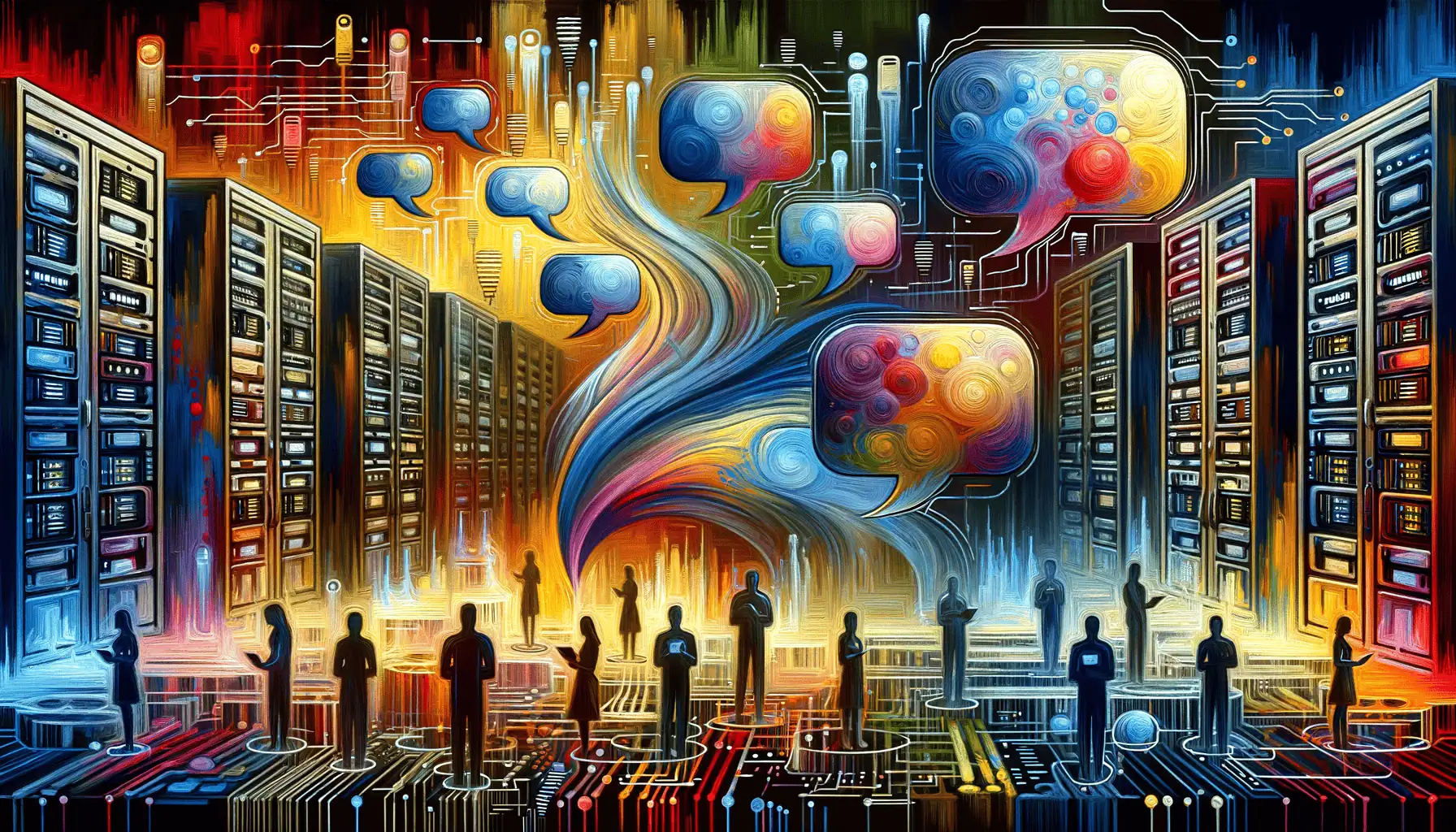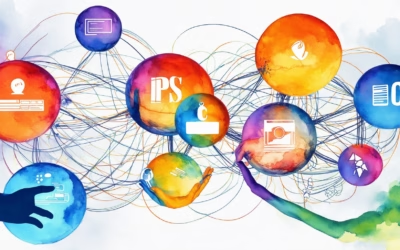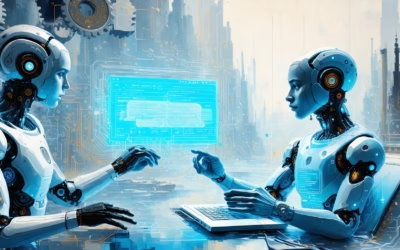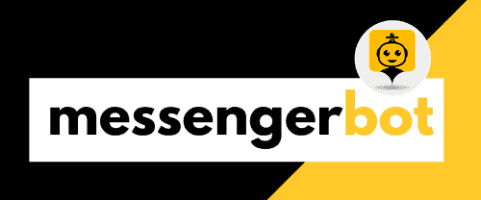In the rapidly evolving digital landscape, chat bot implementation has become a game-changer for businesses seeking to enhance customer engagement and streamline operations. As organizations strive to stay ahead in an increasingly competitive market, mastering the art of deploying chatbots has emerged as a critical skill. This comprehensive guide delves into the intricacies of chat bot implementation, exploring everything from the fundamental components of chatbot architecture to advanced development techniques. Whether you’re looking to develop a chatbot from scratch, integrate one into your existing systems, or optimize your current chatbot solution, this article will equip you with the knowledge and strategies needed to elevate your customer interactions and drive business growth through intelligent automation.
Understanding Chat Bot Implementation
As a pioneer in AI-driven communication solutions, I’ve seen firsthand how chatbots are revolutionizing customer interactions. Implementing a chatbot can seem daunting, but with the right approach, it’s a game-changer for businesses of all sizes. Let’s dive into the essentials of chatbot implementation and explore its key components.
How do you implement a chatbot?
Implementing a chatbot involves several crucial steps:
- Define your objectives: Clearly outline what you want your chatbot to achieve.
- Choose the right platform: Select a chatbot platform that aligns with your needs and technical capabilities.
- Design conversation flows: Map out user interactions and create engaging dialogues.
- Integrate with existing systems: Ensure seamless connection with your CRM, databases, and other tools.
- Train your chatbot: Feed it with relevant data and continuously refine its responses.
- Test thoroughly: Conduct extensive testing to identify and fix any issues.
- Launch and monitor: Deploy your chatbot and closely track its performance.
Remember, the goal is to enhance customer engagement with chat bots online, not to replace human interaction entirely. A well-implemented chatbot should complement your existing customer service strategies.
Key components of chatbot architecture
The architecture of a chatbot is crucial for its functionality and success. Here are the essential components:
- Natural Language Processing (NLP) Engine: This is the brain of your chatbot, enabling it to understand and interpret user inputs.
- Dialog Management System: Manages the flow of conversation and determines appropriate responses.
- Knowledge Base: A repository of information that the chatbot can access to provide accurate answers.
- Integration APIs: Allow the chatbot to connect with external systems and databases.
- User Interface: The front-end where users interact with the chatbot, whether it’s on a website, messaging app, or other platforms.
At Messenger Bot, we’ve refined these components to create a robust chatbot architecture that delivers exceptional results. Our platform seamlessly integrates these elements, making it easier for businesses to implement sophisticated chatbots without extensive technical knowledge.
While there are various chatbot solutions available, such as Zendesk’s AI chatbots, it’s crucial to choose a platform that aligns with your specific needs and can grow with your business. Our solution offers flexibility and scalability, ensuring that your chatbot implementation project plan can adapt to changing requirements.
By understanding these key components and following a structured implementation process, you’re well on your way to harnessing the power of chatbots for your business. Remember, the best chatbot examples are those that not only automate tasks but also enhance the overall customer experience.

Phases of Chatbot Implementation
Implementing a chatbot involves several crucial phases, each contributing to the development of an effective AI-driven communication tool. At Messenger Bot, we’ve refined our chatbot implementation process to ensure seamless integration and optimal performance for businesses of all sizes.
What are the phases of chatbot implementation?
The chatbot implementation process typically consists of five key phases:
- Planning and Strategy: This initial phase involves defining the chatbot’s objectives, identifying target users, and outlining the scope of functionality.
- Design and Development: Here, we create the chatbot’s conversational flow, design its user interface, and develop its core functionality using advanced AI algorithms.
- Integration: During this phase, we integrate the chatbot with existing systems, such as CRM platforms or knowledge bases, to ensure seamless data flow and functionality.
- Testing and Quality Assurance: Rigorous testing is conducted to identify and rectify any issues, ensuring the chatbot performs optimally across various scenarios.
- Deployment and Monitoring: Finally, we launch the chatbot and continuously monitor its performance, making necessary adjustments to improve user experience and efficiency.
Each phase is crucial in creating a best AI chatbot that meets your specific business needs and enhances customer engagement.
Chatbot implementation project plan essentials
A well-structured chatbot implementation project plan is essential for success. Here are the key components to include:
- Clear Objectives: Define specific, measurable goals for your chatbot, such as reducing response times or increasing customer satisfaction.
- Timeline: Establish a realistic timeline for each phase of the implementation process, including milestones and deadlines.
- Resource Allocation: Identify the team members, tools, and budget required for successful implementation.
- Risk Assessment: Anticipate potential challenges and develop mitigation strategies to ensure smooth implementation.
- Training Plan: Outline how you’ll train your team to manage and maintain the chatbot post-implementation.
- Performance Metrics: Define key performance indicators (KPIs) to measure the chatbot’s success and impact on your business.
At Messenger Bot, we understand that each business has unique needs. That’s why we offer customizable chatbot implementation solutions tailored to your specific requirements. Our team of experts will guide you through each phase, ensuring a smooth transition to AI-powered customer engagement.
By following a structured implementation plan and leveraging our expertise in AI-powered customer service bots, you can successfully deploy a chatbot that enhances your customer support experience and drives business growth. Remember, the key to a successful chatbot implementation lies in thorough planning, continuous testing, and ongoing optimization.
III. Complexity of Chat Bot Programming
Implementing a chatbot can be a complex process, but with the right tools and knowledge, it’s becoming increasingly accessible. The complexity of chat bot implementation varies depending on the desired functionality and the platform you’re using.
While simple rule-based chatbots can be relatively straightforward to program, more advanced AI-powered chatbots require a deeper understanding of natural language processing (NLP) and machine learning algorithms. These sophisticated chatbots online can handle complex conversations and learn from interactions, making them more challenging to develop but ultimately more valuable for businesses.
A. How hard is it to program a chat bot?
The difficulty of programming a chatbot depends on several factors:
- Complexity of the chatbot’s intended functionality
- Choice of programming language and framework
- Integration requirements with existing systems
- Level of natural language understanding needed
For beginners, platforms like Dialogflow or Botpress offer user-friendly interfaces to create basic chatbots without extensive coding knowledge. However, for more advanced features, such as those offered by the best AI chatbots, programming skills become essential.
Experienced developers can leverage frameworks like Rasa or Microsoft Bot Framework to create sophisticated chatbots. These tools provide powerful capabilities but require a deeper understanding of programming concepts and AI technologies.
B. Chatbot implementation in Python: A practical approach
Python is a popular choice for chatbot development due to its simplicity and robust libraries. Here’s a practical approach to implementing a chatbot using Python:
- Choose a framework: NLTK or spaCy for natural language processing.
- Design the chatbot’s architecture: Define intents, entities, and conversation flow.
- Implement NLP functionality: Use machine learning algorithms for intent classification and entity extraction.
- Develop the conversation logic: Create functions to handle different user inputs and generate appropriate responses.
- Integrate with messaging platforms: Use APIs to connect your chatbot to platforms like Facebook Messenger or Slack.
- Test and refine: Continuously improve your chatbot’s performance based on user interactions.
For those looking to develop a chatbot quickly, our platform offers a user-friendly interface that simplifies the process, allowing you to create sophisticated AI-powered chatbots without extensive coding.
While programming a chatbot can be challenging, the rewards are significant. Chatbot examples across various industries demonstrate their ability to enhance customer engagement, streamline operations, and provide 24/7 support. As AI technology continues to advance, we can expect chatbot development to become more accessible, opening up new possibilities for businesses of all sizes.
Benefits of Implementing Chatbots
Implementing chatbots in your business strategy can revolutionize customer interactions and streamline operations. As a leading chat bot implementation platform, we’ve witnessed firsthand the transformative power of these AI-driven assistants. Let’s explore the compelling reasons why businesses are increasingly turning to chatbots and how they can enhance customer engagement online.
Why implement a chatbot?
Chatbots offer numerous advantages that can significantly impact your business’s efficiency and customer satisfaction:
- 24/7 Availability: Unlike human agents, chatbots can provide round-the-clock support, ensuring that customer inquiries are addressed promptly at any time.
- Cost-Effectiveness: By automating routine tasks, chatbots reduce the need for large customer service teams, leading to substantial cost savings.
- Scalability: Chatbots can handle multiple conversations simultaneously, allowing businesses to scale their customer support without proportionally increasing resources.
- Consistency: AI-powered chatbots deliver consistent responses, eliminating the variability that can occur with human agents.
- Data Collection: Chatbots can gather valuable customer data and insights, helping businesses refine their products and services.
Implementing a chatbot through platforms like Messenger Bot can dramatically improve your customer service capabilities and operational efficiency. Our AI-driven solution integrates seamlessly with various channels, including websites and social media platforms, to provide a cohesive customer experience.
Enhancing customer engagement with chat bots online
Chat bots online are revolutionizing the way businesses interact with their customers. Here’s how they’re enhancing engagement:
- Personalized Interactions: Advanced AI chatbots can tailor conversations based on user history and preferences, creating a more personalized experience.
- Instant Responses: Chatbots provide immediate answers to common questions, reducing wait times and improving customer satisfaction.
- Guided Conversations: By asking relevant questions, chatbots can guide users through complex processes or help them find the right products.
- Multilingual Support: Many chatbots, including our multilingual messenger bots, can communicate in various languages, breaking down language barriers and expanding global reach.
- Proactive Engagement: Chatbots can initiate conversations based on user behavior, offering assistance or promotions at optimal moments.
To maximize the benefits of chatbot implementation, it’s crucial to choose a robust platform. While there are several options available, including Zendesk and Drift, our Messenger Bot platform offers unique features tailored to enhance customer engagement and support.
By leveraging AI-powered chatbots, businesses can create more engaging, efficient, and personalized customer experiences. As we continue to innovate in the field of conversational AI, the potential for chatbots to transform customer interactions is boundless. Implementing a chatbot is not just about keeping up with technology; it’s about setting a new standard for customer engagement in the digital age.
V. Integrating Chatbots into Existing Systems
Integrating chatbots into existing systems is a crucial step in chat bot implementation. As businesses increasingly recognize the value of automated customer interactions, the demand for seamless integration has grown. This process involves carefully merging chatbot functionality with current websites, CRM systems, and other digital platforms to enhance user experience and streamline operations.
One of the key advantages of modern chatbot solutions is their flexibility. Platforms like Messenger Bot offer easy integration options, allowing businesses to implement chatbots without overhauling their entire digital infrastructure. This adaptability is essential for companies looking to enhance their online presence without disrupting existing workflows.
A. How to implement chatbot in website
Implementing a chatbot on your website can significantly improve user engagement and support. Here’s a step-by-step approach to integrating a chatbot into your website:
- Choose the right chatbot platform: Select a solution that aligns with your business needs and technical requirements. Messenger Bot, for instance, offers a user-friendly interface and robust features suitable for various industries.
- Customize your chatbot: Tailor the chatbot’s responses and functionality to match your brand voice and address common customer queries.
- Add the chatbot widget: Most chatbot providers offer a simple code snippet that you can add to your website. This typically involves pasting the code into your site’s HTML, often just before the closing






